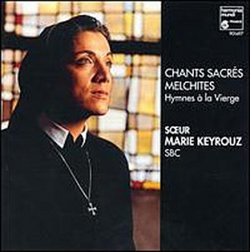| All Artists: Soeur Marie Keyrouz SBC, L'Ensemble De La Paix Title: Chants Sacrés Melchites (Melchite Sacred Chant): Hymnes à la Vierge (Hymns to the Blessed Virgin) Members Wishing: 0 Total Copies: 0 Label: Harmonia Mundi France Release Date: 5/17/1994 Album Type: Import Genre: Classical Style: Number of Discs: 1 SwapaCD Credits: 1 UPC: 093046149727 |
Search - Soeur Marie Keyrouz SBC, L'Ensemble De La Paix :: Chants Sacrés Melchites (Melchite Sacred Chant): Hymnes à la Vierge (Hymns to the Blessed Virgin)
CD Details |
CD ReviewsReview (from Gramophone) Slobberer | Astoria, NY United States | 01/26/2009 (5 out of 5 stars) "Melchite Sacred Chant Hymns to the Blessed Virgin. Sister Marie Keyrouz (sop); L'Ensemble de la Paix. Harmonia Mundi © HMC90 1497 (63 minutes: DDD: 9/94). Recorded 1993.
With very little hint of nasality or of singing from the throat. Sister Marie Keyrouz accomplishes the most florid ululations with the greatest of ease, the voice continuously and impressively set in relief by a reverberant acoustic and a drone bass provided by a small choir of male voices. The area touched on by this extremely rare repertory is a fascinating one, not much illuminated by the brief, at times almost impenetrable notes provided. The Melchite churches of the Near East in the fourth and fifth centuries AD were those that remained, in a period of frequent schism, faithful to Byzantium ('Melchite' derives from a Syriac word meaning 'Emperor'). The liturgy of these churches was very influential: many of the most famous hymns of the Orthodox church, for example, were composed in the sixth century by Romanes the Melodist in Syriac style; like Sister Marie, Romanes was bom in what is now the Lebanon. So some of these melodies, if authentic, may be part of a repertory more ancient than any other surviving Christian chant. For the earlier part of their history, of course, they would have had to rely on oral transmission for their survival. How far they were changed in that process, how far they were affected by an Islamic tradition growing up around them and by translation of their texts from Greek and Syriac into Arabic, only a specialist could say; certainly the notes accompanying this collection do not. This would be only a quibble were not three of the longer chants attributed to Sister Marie herself, described either as "in improvised style" or as "written improvisation"; one of these is a setting of part of Romanes's most celebrated text, the Akathistos. The main difference between these and most of those whose origin is unattributed is their greater virtuosity: in them Sister Marie uses a wider vocal range, a rather more dramatic, declamatory utterance and still more florid melismata. It makes fascinating listening: a border territory between Christian and Islamic chant, at times revealing a modal simplicity beneath the flexible ornament, at others well-nigh hiding it in ecstatic, microtonal wailings. " |


 Track Listings (14) - Disc #1
Track Listings (14) - Disc #1